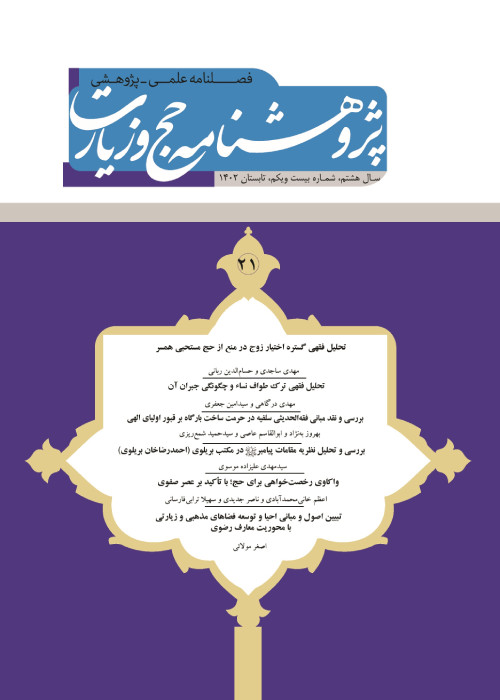Comparison of the Ideology and Behavior of the Salafi and Wahhabi Strand of Thought With the Behavior of the Sunni in Visiting the Tomb of the Prophet (ṣ)
Author(s):
Abstract:
As for visiting the tomb of the Prophet (ṣ), four viewpoints exist among the Sunni: Some say that it is an emphatically recommended act or even obligatory; another group says that it is mubāḥ (allowed but without any reward or punishment); the third group says it is makrūh [disliked] and conditionally prohibited; and the fourth and final group says that it is absolutely prohibited. The Salafis and Wahhabis who constitute the fourth group, consider visiting tombs including the shrine of the Prophet (ṣ) as being of two types: religiously sanctioned visit and heretic and prohibited visit. Meanwhile, a group of people known as Salafis such as Ibn Taymiyyah, Ibn Qayyem, and their adherents believe that from the very beginning of Islam, visiting the tombs of people has been forbidden. Then, the Prophet (ṣ) has abrogated that law and enjoined people to visit the tombs of people. Therefore, its prohibition is conditional when first, [the hadith] shadd al-riḥāl [setting out on journey] is applied to it, and second, when religiously prohibited acts are committed near them such as stopping near the grave, making requests, seeking intercession, and eulogizing and sending peace. Otherwise, it is lawful and permissible. The fourth group including Ibn Baṭṭāl, Ibn Baṭṭah, Ibn Sīrīn, Ibrāhīm Nakha‘ī, Sha‘bī, and contemporary Wahhabi scholars view visiting the tomb of the Prophet as absolutely prohibited even without shadd al-riḥāl. In this research, we aim to answer this question as to what ideological and behavioral differences exist between the whole of the Sunni and the Salafis and Wahhabis on this subject. To do so, the beliefs and views of the four groups will be studied by presenting narrations from the Prophet (ṣ) as well as by considering behavior of the Prophet’s companions, the tā’ibīn [the contemporaries of the companions who did not see the Prophet], and scholars of the Islamic denominations in narrational and historical texts of the Sunni about visiting the Prophet’s tomb. The results of this study show other than the existence of narrations which speak of the desirability [istiḥbāb] and emphatic recommendation of visiting the tomb of the Prophet (ṣ) in hadith books of the Sunni, additionally the companions of the Prophet (ṣ), the tā’ibīn, jurists, and grand figures of Islamic denominations would visit the Prophet and did not consider shadd al-riḥāl as contradictory to it. Therefore, on this subject, a marked and meaningful difference can be observed between the views of the Sunni in general, and the Salafi and Wahhabi strand of thought in particular.
Keywords:
Language:
Persian
Published:
Hajj and Ziarah Research Journal, Volume:2 Issue: 2, 2018
Pages:
35 to 65
magiran.com/p1919678
دانلود و مطالعه متن این مقاله با یکی از روشهای زیر امکان پذیر است:
اشتراک شخصی
با عضویت و پرداخت آنلاین حق اشتراک یکساله به مبلغ 1,390,000ريال میتوانید 70 عنوان مطلب دانلود کنید!
اشتراک سازمانی
به کتابخانه دانشگاه یا محل کار خود پیشنهاد کنید تا اشتراک سازمانی این پایگاه را برای دسترسی نامحدود همه کاربران به متن مطالب تهیه نمایند!
توجه!
- حق عضویت دریافتی صرف حمایت از نشریات عضو و نگهداری، تکمیل و توسعه مگیران میشود.
- پرداخت حق اشتراک و دانلود مقالات اجازه بازنشر آن در سایر رسانههای چاپی و دیجیتال را به کاربر نمیدهد.
دسترسی سراسری کاربران دانشگاه پیام نور!
اعضای هیئت علمی و دانشجویان دانشگاه پیام نور در سراسر کشور، در صورت ثبت نام با ایمیل دانشگاهی، تا پایان فروردین ماه 1403 به مقالات سایت دسترسی خواهند داشت!
In order to view content subscription is required
Personal subscription
Subscribe magiran.com for 70 € euros via PayPal and download 70 articles during a year.
Organization subscription
Please contact us to subscribe your university or library for unlimited access!



